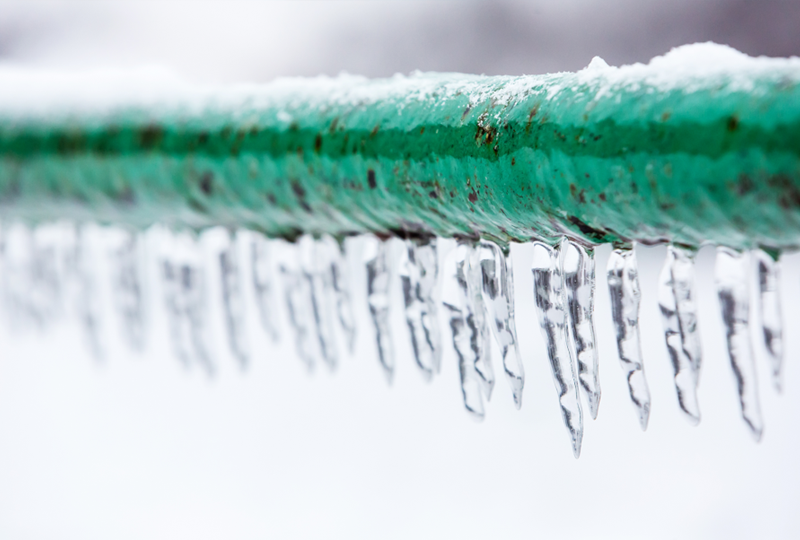
Whether sub-zero temperatures have you bundled in layers or the wind chill doesn’t faze you, it’s important to understand the impact of freezing temperatures on your home.
Here are some insights you can use to prevent freezing pipes in your home — or to address the damage if the worst-case scenario occurs.
Key insights:
- Pipes can freeze when temperatures are at or below 32 degrees Fahrenheit, but there are ways to prevent it from happening in your home.
- Spot a frozen pipe by looking for frost and other common indications of a freeze.
- Know what to do — and act fast — if your pipes do burst this winter.
Why do pipes freeze and burst?
When winter rolls around and temperatures drop, the change in climate could impact your home. Pipes are more likely to freeze during winter months when the forecast is below freezing and the frozen pipes can cause water in the line to turn into ice.
And of course, water expands as it freezes, so the pressure that builds in icy pipes can result in a burst. If a pipeline bursts, serious and costly damage might occur — such as flooding, mold growth and water damage. However, you can take preventative measures to avoid frozen and bursting pipes in your home this winter.
How can I prevent freezing pipes this winter?
Protect your home from frozen pipes this winter by following these simple steps:
- Keep your heat on, even if you’re leaving town, and don’t let the temperature in your house drop below 55 degrees Fahrenheit.
- Seal any cracks in walls or floors.
- Relieve potential pressure buildup by letting a faucet in the back of your home drip.
- Promote air circulation by keeping the cabinets and doors that surround pipes open. (Be sure to remove anything dangerous from those areas if you have children.)
- Add insulation (like a pipe sleeve or heat tape) to pipes that are exposed to extra cold.
Be sure to pay special attention to pipes that are located near cold exterior walls, out in the garage, down in the basement or up in the attic. These pipes may be more susceptible to freezing and bursting, as they’re likely located in unheated areas of the home.
Spot a frozen pipe before it bursts
It’s not uncommon that pipes freeze in the winter, even if you’ve covered all your bases to prevent it. Keep your eyes open for freezing pipes by staying alert for these common signs:
- Reduced water flow from faucets and toilets
- Frost-coated waterlines
- Strange odors coming from the drain
- Bulging pipes
These are telltale signs that a pipe could be frozen and at risk of bursting. If you notice one or more of these frozen pipe indications, it’s time to act quickly.
What can I do if my pipes do freeze or burst?
If you suspect a frozen pipe, you’ll want to take action before matters get worse. The American Red Cross suggests these pipe thawing methods:
- Keep the faucet open and water running, which reduce the pressure in the short-term and will eventually cause the ice to thaw.
- Warm pipes with a heating pad, hair dryer, portable space heater or towels soaked in hot water.
- Check all other pipes for potential damage.
Catching a frozen pipe before it bursts will save you a lot of hassle, but it’s not always possible to identify a frozen pipe. Here’s what you can do if your pipe bursts:
- Shut off your water supply to prevent excess damage.
- Dry as much water as possible with a sponge, mop or towels.
- Call a licensed plumber.
- Speak with your insurance agent; your homeowners insurance policy may cover the cost of repairing the damage.
Key takeaways on frozen pipe prevention
Don’t let freezing pipes burst your winter spirit. Be aware of frozen pipes and do what you can to avoid potential damage by:
- Prepping your home in advance to prevent frozen pipes
- Keeping watch for the signs of icy pipes
- Knowing the safest ways to react if a pipe freezes or bursts in your home
If you have a serious freeze, or you walk into your home to see Niagara Falls bursting out of your pipes, call a professional. An expert will be able to assess the situation and get your pipes running smoothly again.
And remember, if you have homeowners insurance, the damage from a pipe inside your home is typically covered in a standard policy. Get in touch with your Edina Realty insurance agent if you’d like to check your coverage.







